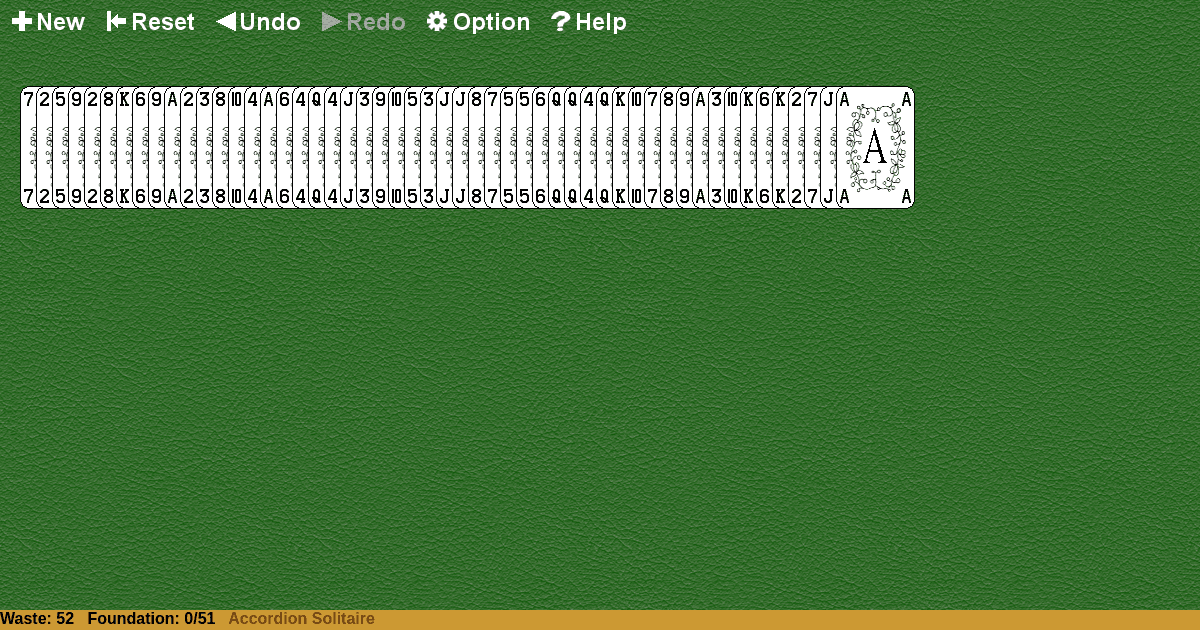Accordion
Home |
How to play |
FAQ |
About
How to play Accordion?
Game Objective
The objective of Accordion Solitaire is to combine all 52 cards from a standard deck into a single pile by stacking cards according to specific matching rules.
Setup
- Shuffle a standard 52-card deck thoroughly.
- Deal all cards face up in a single row from left to right. If space is limited, cards may be dealt in multiple rows, but they are considered as one continuous sequence (e.g., four rows of 13 cards).
- There are no separate play areas such as foundations, stock, reserve, or waste piles. All cards are in the tableau (the main row of cards).
- All cards are always face up and visible.
Gameplay / Turn Structure
- On your turn, examine the tableau for possible moves:
- You may move a card (or a pile of cards) onto another card or pile if:
- The card to be moved matches the destination card in rank (e.g., both are 7s) or suit (e.g., both are hearts).
- The destination card is either:
- Immediately to the left (one position left), or
- Three positions to the left.
- You may move a card (or a pile of cards) onto another card or pile if:
- When a card or pile is moved, all cards to its right are shifted left to fill the empty space, maintaining a continuous row.
- Only the top card of each pile is considered for matching and movement.
- Continue making moves as long as legal moves are available. Moves are not mandatory; you may choose which legal move to make if multiple options exist.
- The game proceeds until no further moves are possible or all cards are combined into one pile.
Legal Moves Summary
- A card/pile can be moved onto the pile:
- Immediately to its left (1 position) if they match in rank or suit.
- Three positions to its left if they match in rank or suit.
Winning the Game
- You win if you successfully combine all 52 cards into a single pile.
- The game is lost or unwinnable if no further legal moves are possible and more than one pile remains.
Key Rules & Edge Cases
- Empty Spaces: After moving a card or pile, immediately slide all cards to the right of the gap leftward to maintain a continuous row; empty spaces are never left in the tableau.
- Pile Movement: When moving a pile, always move the entire pile, not just the top card.
- Multiple Move Options: If a card can be moved either one or three positions to the left, you may choose which move to make; strategic choice can affect the outcome.
- No Foundations or Stock: There are no foundations, stock, reserve, or waste piles in Accordion Solitaire; all play occurs in the tableau.
- No Redeals: Once all cards are dealt, there are no redeals or resets.
- Difficulty: The game is considered very difficult to win; reducing the tableau to even four or fewer piles is regarded as a relative success.
This ruleset covers all essential mechanics and edge cases for playing Accordion Solitaire according to standard sources.

Solitaire Collection
Frequently Asked Questions
-
What is the objective of Accordion Solitaire?
The objective is to compress all 52 cards into a single pile by stacking cards according to the rules. If you cannot achieve one pile, reducing to as few piles as possible is considered a relative success.
-
How do you set up Accordion Solitaire?
Shuffle a standard 52-card deck and deal cards one at a time face up in a row from left to right. There are no foundations or tableau piles—just a single line of cards.
-
What are the rules for moving cards in Accordion Solitaire?
You can move a card onto the pile immediately to its left or onto the pile three places to its left if the top cards match in suit or rank. After a move, the entire pile is moved as a unit.
-
Can you move piles or only single cards?
When a pile is formed, you can move the entire pile as a unit, not just the top card. Moves are always based on the top card of each pile.
-
Is it possible to win Accordion Solitaire every time?
Accordion Solitaire is considered very difficult to win, with the odds of success being extremely low. Most games end with multiple piles remaining.
-
Are there strategies to improve your chances of winning?
Common strategies include planning moves ahead, prioritizing moves that open up future stacking opportunities, and sometimes delaying moves to keep options open. However, luck plays a significant role.
-
Can you undo moves or is every move final?
Traditionally, once a move is made, it is final. Some digital versions may offer an undo feature, but this is not part of the classic rules.
-
What happens if no more moves are possible?
If you cannot make any more legal moves, the game ends. Your score is the number of piles remaining; the fewer, the better.
-
Can you play Accordion Solitaire with more than one deck?
Accordion Solitaire is traditionally played with a single 52-card deck. Using multiple decks is not standard and would significantly alter gameplay.
-
Are there common rule variations for Accordion Solitaire?
The core rules are generally consistent, but some players allow stacking at greater intervals (e.g., five to the left) or introduce wild cards. These are house rules and not part of the standard game.



























































